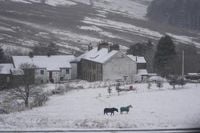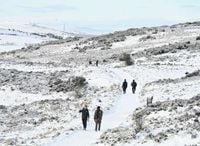The United Kingdom is bracing for a dramatic shift in weather as an Arctic blast sweeps across the country, bringing with it the coldest temperatures since March, a heightened risk of snow and ice, and a flurry of official warnings. The cold snap, which began to take hold over the weekend, is expected to intensify through the week of November 17–21, 2025, affecting nearly every corner of the UK—from the Scottish Highlands to the valleys of Wales and the hills of Northern Ireland.
According to Sky News, the temperature at Tulloch Bridge in the Highlands plummeted to -7°C (19.4°F) on Saturday night, marking the coldest night since March. This abrupt chill comes on the heels of Storm Claudia, which lashed southern England and Wales with heavy rain, leading to severe flooding and a major incident declaration in Monmouth. But the rain is giving way to a new set of hazards: widespread frost, biting winds, and the looming threat of snow and ice.
The Met Office, the UK’s national weather service, has been at the forefront of issuing warnings and updates. Deputy chief meteorologist Dan Holley explained the science behind the sudden freeze: “High pressure to the northwest will drive a cold northerly flow from the Arctic, bringing with it much colder conditions than of late.” He added, “There will be widespread frosts across the UK, with temperatures dipping as low as -7°C in places next week, and daytime temperatures staying in single figures across the country. Couple this with a brisk northerly wind, and there will be a marked wind chill. This will be a notable change in our weather after a prolonged spell of above-average temperatures.”
Holley’s words are echoed by Simon Partridge, another Met Office meteorologist, who told The Independent, “It’s certainly going to turn much colder over the next couple of days, there will be an eight to 10 degree drop in temperature, you will be struggling to get double figures. We will probably see our first widespread countrywide frost on Monday morning and the lowest temperatures will be somewhere between minus 5°C and minus 7°C.”
The UK Health Security Agency (UKHSA) has responded by issuing a yellow cold weather alert for the East Midlands, West Midlands, North East, North West, and Yorkshire and The Humber. The alert, effective from Sunday, November 16, until Friday, November 21, warns of a potential rise in deaths among over-65s and people with health conditions, increased demand for healthcare services, and risks for vulnerable people unable to keep indoor temperatures at the recommended 18°C. The agency underscored that alerts are issued when cold weather is forecast that could have significant health impacts, especially for those most at risk.
The cold spell is not confined to mainland Britain. Northern Ireland, too, is under threat from the Arctic air mass. According to Belfast Telegraph, the Met Office expects nighttime temperatures to dip below zero as the week progresses, with snow and ice likely by the end of the working week. Tom Morgan, a Met Office meteorologist, described the unfolding situation: “Monday will start on a cold and frosty note in the morning, it will be a fine and sunny day for many of us, just a bit of fair weather cold and generally dry. Make the most of the sunshine as it’s not going to last. We will see thick cloud arriving and outbreaks of rain towards the end of Monday night into Tuesday. It’s quite a messy picture on Tuesday, with quite blustery winds, feeling pretty cold.”
As the week advances, the outlook for precipitation is set to change. Morgan continued, “Most of the showers will be falling as rain on Tuesday, but as we go towards the middle part of the week, there is an increasing chance of some snow, initially over the higher ground, but I think there could well be a covering of snow down in some lower levels through the day. Over the Sperrins, over the Mournes etc, that’s where we’re more likely to see several centimetres by the end of Wednesday. At lower levels, it’s more likely to be kind of transient snow, not lasting too long, but it will lead to risk of ice overnight.”
Travelers are being advised to exercise caution. “Leave yourself longer for your journeys to work, whether that’s defrosting your car or just generally driving more slowly and to the conditions of the road. If you’re not driving, pavements will be potentially quite icy,” Morgan warned. The cold snap comes as a stark contrast to the unseasonably warm start to November; in Northern Ireland, average temperatures at the start of the month were 2.7°C above normal, according to the Met Office.
Elsewhere in the UK, the Met Office and other forecasters are predicting the first snows of winter in more than 20 areas, as reported by OpenWeather and Gloucestershire Live. Snow is expected to arrive on Monday in parts of Scotland and the North East, with the possibility of snow in Wales and even Gloucestershire in the South West by Tuesday. Northern Ireland may see snow by Wednesday, while night-time temperatures across the North West of England could drop to -2°C on Tuesday, with widespread overnight lows between 0–2°C across central England and Scotland on Wednesday.
There is a growing chance of sleet and snow, especially over hills and mountains in Scotland, Northern Ireland, northern England, and possibly North Wales. By the end of the week, a widespread wintry spell could affect the UK, including southern regions, with some models suggesting a 20% or greater chance of more than 1cm of snow even in the south. Alongside the snow, there is also a risk of ice, particularly where rain falls onto cold surfaces.
The Met Office’s blog post summed up the evolving situation: “The probability of snow increases as we move through the period. Friday’s wet weather in the south could bring wintry conditions to the hills of northwest Wales. By Sunday and Monday, as colder air digs in, there is a reasonable chance of sleet and snow in northern Scotland, with the risk spreading further south into Northern Ireland, northern England, and North Wales by Tuesday. The middle and end of next week could see a more widespread wintry spell if a weather system moves south, with some models suggesting a 20% or greater chance of more than 1cm of snow even in southern parts of the country. Alongside snow, there is also a risk of ice, especially where rain falls onto cold surfaces.”
While Thursday is expected to bring drier and sunnier conditions for most areas, overnight frosts will persist, and the risk of icy surfaces remains high. The Met Office has indicated that further warnings for snow and ice may be issued as the situation develops.
With the abrupt end to the recent spell of mild weather and the arrival of Arctic air, the UK’s first widespread frost and snow of the season are set to test the nation’s resilience—and its readiness for winter’s challenges.





